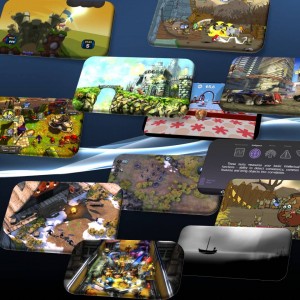Just How “Indie” Are Indie Games?
by Gideon, HSM team writer
In the wake of skyrocketing game development costs of the current generation of consoles, the surge of independently developed videogames gives the capable every-man hope in what seems to be an increasingly monolithic industry. Many smaller, and at times single-manned, development studios have proven that it is possible for a creative team with capable minds to make their mark on the videogame landscape in ways larger companies and projects can only dream of.
One brick at a time, independent games poke holes in the confining walls of the industry standard concepts of what a videogame should be. Past the concrete street littered with steel and bullets and one dimensional characters and faceless heroes and linear levels and iron sights and large breasts and dirty jokes and re-releases and sequels, we see a world full of wonder, amazement, joy, hope, dreams, adventure, creativity and something new.
In 2011 the independent game industry (which in and of itself, seems like a misnomer) has taken further steps to becoming legitimized through the efforts of many large game companies and publishers. Gaining recognition and support for their efforts, many independent studios are enjoying something that those that have come before them have craved and strove for, but have sorely lacked: financial backing.
Since today’s media distribution doesn’t rely solely on the pressing of optical disks, printing of booklets, molding of cases, packaging of boxes, shipping of material and stocking of shelves, publishers can take the risk of backing smaller, lesser known titles. This, in turn, takes some of the financial pressure off of these independent studios, allowing them to focus on what they set out to do, make cutting edge games that stretch the very definition of what a game is and could be.
This, of course, raises an almost paradoxical perplexity: at which point does an Indie video game lose its independent label?
Many would argue that a good deal of the games recently featured on the PlayStation Blog in the post titled “Celebrating PSN’s Top-Selling Indie Games of 2011” aren’t actually Indie games. The article provided readers with three categories which separated the top selling Indie games of 2011.
Third Party Self-Published Indie games are games which are fully developed and fully funded by an independent studio. These are the studios from which rare gems like Limbo and Braid originate. These are the studios that many gamers look to for game innovation and game-play originality. This is Indie gaming at its purest.
The post then breaks away from the pure Indie concept and lists the ten best selling SCEA-Published indies. These are development studios which are backed and funded by Sony. Some of the best titles on any platform are squarely seated on the PSN because of this category. Pixeljunk Shooter 2, Flower, Super Stardust HD and Linger In Shadows all come from this category. A gamer would be hard pressed to find games that embody the tenants of Indie video games more than the titles on this list.
In 2011 Sony established the Pub fund, which is meant to infuse in-development Indie titles with the funds and resources so the developers’ creative visions can be realized. This is a concept that is, in and of itself, an oxymoron. An independent game which is funded by a large publishing studio is no longer an independent game. Yet some of these games would not otherwise be realized if it weren’t for the Pub fund, making their very creation dependent on another studio. Once an independent game becomes dependent on the large supporting studio for financial resources, the game should rightfully lose its independent status. While it’s not for the games to besmirch these developers for taking some candy when its offered, it shouldn’t be acceptable to claim a title independent when it is everything but, no matter how humble the game’s beginnings.
This isn’t to say that it isn’t a wonderful thing Sony has done with the Pub Fund. The program has brought us some beautiful titles such as Eufloria and Tales From Space: About a Blob, but it completely debases the concept of an independent title. Perhaps the question that should be asked is what, exactly, does it matter whether or not a videogame is independent?
Theoretically, an independent studio would have more creativity and freedom to explore new avenues of storytelling and gameplay. However, in today’s super-charged market of FPS sequels and videogame knockoffs it’s important to seek innovation in an otherwise crusting industry. Even larger developers realize this. If companies such as Sony weren’t searching for new and creative ways for gamers to game, would Little Big Planet or Catherine have ever gotten past the conception stage? Is it true that just because a game is an independent game, it is somehow mystically infused with the power of the ancient gaming gods to be a more creative and enjoyable title? Definitely not, but the stereotype is there and every game company knows this.
This is where the casual onlooker that pays a moderate amount of attention can see the propaganda machine at work. Today, the ability to label a video game an Indie automatically gains it additional attention from the gaming community. Indie games are sought out in much the same way Indie music or Indie films are sought after.
By funding Indie games in multiple ways, Sony both supports and undermines the independent game movement. Providing a small independent development team with some cash inevitably establishes a relationship of responsibility and expectations. Through conjecture, the conclusion could be reached that a development team who accepts funds from Sony would be held to certain standards and deadlines that a truly independent team would be free of. Conversely, it could also be concluded that a team who is funded by Sony gains the expertise and tool sets that is usually reserved for larger publishing teams, and as anyone who has ever changed a serpentine belt without the proper tool knows, the right tools can make a world of difference when trying to get a job done.
To further assert the PSN as the premier destination for Indie titles, the blog post throws definitive statements around like a hyper child who’s gotten their hands on a case of silly string. The particular wording chosen by the writers of the PlayStation Blog used to describe the PSN as “the only platform to fully embrace Indie developers” is interesting to say the least. At first read, the statement seems to claim that the PSN is the best place for independent developers to get their works known and the best place for gamers to find Indie titles. Unfortunately, both of these statements are simply untrue.
There are far greater, and simpler, outlets for independent developers to get their games noticed, to get their games published and to get their games into the hands of paying consumers. The PSN, as far as the every-man is concerned, is a closed publication system. Developers – independent or otherwise – need to go through a certification process in order to get their games on the PSN. While Sony’s outreach might make the process easier, it’s still red tape that will discourage many smaller independent developers with little to no budget from pursuing PSN publication. Of course, this fist impression of the meaning of what it means to “fully embrace” the independent game movement could be quite different than Sony meant it to be understood.
While the PSN is arguably not the best platform for every wannabe developer to try to get their material out there and in the public eye, it does seem to be the crème de la crème of Indie publishing environments. Instead of simply providing a platform with which to publish games, Sony is offering – with the PSN – a full suite of support features. These features will ensure that any Indie game that makes its way to the PSN is all it was meant to be, and in some cases, possibly more. In this way, Sony is fully embracing Indie developers by taking them into their warm comforting arms and telling them that everything will be alright; Sony’s here to make sure you know what you’re doing. No other Indie publishing environment will guide, encourage, promote and assist like Sony will. In turn, the Indie games that are churned out on the PSN are some of the best in the industry. Some even attempt to attain the production values of fully fledged big-publisher titles, and some succeed.
Even Sony’s treatment of the end product is considerably different from other distribution outlets. Most would consider the PSN’s lack of an Indie channel to be an indication of the PSN’s apathy when it comes to its support for Indie titles. This could be, just as the statement made on the PlayStation blog, a simple matter of interpretation. Sony treats its Indie titles with just as much import as they treat their full publisher releases. Indie games are placed alongside all other games on PSN in their appropriate genre categories and, not surprisingly, the Indie titles tend to stand up when compared.
With all this glowing and swooning over Sony’s handling of their Indie titles, it’s important to remember that Sony’s “Embracing Method” isn’t necessarily the best way to get Indie titles on the in the hands of the average gamer. Not every great Indie title ends up on the PSN, and not every Indie game nestled away within the folds of the PSN is made of pure gaming gold. For the most part, the end product of Sony’s embrace is the assurance for the consumer that an Indie game released on the PSN is likely a more refined product than the average Indie game.
As 2012 commences, and the PSN begins the 340-something day journey to the PlayStation Blog post “Celebrating PSN’s Top-Selling Indie Games of 2012,” there is no shortage of independent studios stepping up to the podium to present their labor of love to the gaming community. The release of games like Botanicula, The Iconoclasts, Pid, Fez, The Witness, and Monaco (to name but a few) is sure to make 2012 a year that is chocked full of great games.
Nevermind their developer’s independence, games such as Journey, which are built on a foundation of creativity, passion and drive, can prove in 2012 that the independent game movement hasn’t necessarily flourished a new genre of game, but has enfused the entire industry with the sense of wonder and excitement that hasn’t been felt since the early days of gaming, when sprites were cutting edge and sonnets were made of midi.
Now, let’s just hope that Sony’s embrace finds Bastion and Minecraft (or better yet, Terraria) sooner rather than later.







Great article, Gideon.
Good read as always Gideon, glad to see you haven’t lost your flare! I am not into Indie Games that much, but I might have to give a few a try sometime, you make them sound very interesting.
Braid and Limbo are hands down two of the best games I’ve ever played. They’re short too, which is sometimes very appreciated! lol!
I actually tried the Limbo demo once. I played it through, it was quirky and different, but not my kind of game as I am almost solely an RPG fan. If Braid had a demo I might try that out as well. I will look at it today. If a game has RPG elements to it it is more likely to catch my attention. Puzzlers and such aren’t my cup of tea, but I do have to say that Limbo’s graphics were very different from anything I had ever seen before being all black and white.
Journey is by far and away the most anticipated new release for 2012 for me. I can’t begin to tell you how excited I am to play that game; it just looks so stunning.
Did you play the Beta? I didn’t get to despite my efforts.
I’m totally right there with you Terra. Journey is numero uno on my list without a doubt!
I didn’t get into the beta -- wish I did though. Thatgamecompany just seems to have the right mix of compelling gameplay, simple yet beautiful visuals, and length (especially length, as at this point in my life, I can’t really commit the hours a storyline like Skyrim’s would require of me).
I am wondering if this applies to not just games but Home spaces and items (clothing, weapons, music etc). And I wonder if it would be possible for Home users to develop things that would be accepted by Sony. And I wonder (more importantly) if there are Home users talented enough to program such things.
I certainly don’t know the business side of things and I don’t know business at all or the facts of how to do it. But I don’t deal in facts. I deal in dreams and listening to and making music.
However, it is my understanding that it costs to purchase a programming kit from Sony, somewhere from $5,000 to $10,000 for a developer’s kit? But I don’t know the facts, do I? No, I don’t.
I believe it would be ultra cool (hot?) if Home users could get together and raise founds to create something. Were I CEO of a formed company my priorities if funds were raised would be a farm or city park and more items like the Halloween horror band trio which is quite good (when one gets past their horrific looks ;). So cool it would be to have an Elvis Presley hippy hippy pelvic thruster item which played 2 or 3 of his tunes. Or a Home user like Musicman1234 (I’m a fan). I prefer Elvis and truth be known I’d prefer Del Shannon or Roy Orbison over both of them. But I want the farm or city park first. I think what little business wisdom I have just realized that an Indie wouldn’t make a public space like a city park, so the farm it is. “In Dreams”. Get it?
But I don’t deal in facts, I deal in dreams. Sometimes that is good and sometimes it is not.
You deal in dreams,I as cthulu deal with madness.You prefer Elvis,I prefer Pink Floyd.You like the Halloween band,I prefer the lady dancers.There is a wide range of tastes and preferences of Home users and the more that developers feed these the better they will do financially.Which is why the recent releases by Lockwood and others will do quite well IMO.It’s much more profitable to find out what people want and give it to them than to create something and tell or expect people to buy into it.In other words,it’s easier to feed an existing market than to try to create a market based on uncertain demand.It’s not impossible to create new markets from uncertainty but it has more risk.Personally I could watch an Elvis concert,especially if it’s the older,fatter Elvis,if there was a Pink Floyd concert right after.Heck I’d even pay to watch this.Hint,hint,Sony lol.
We are more likely to get things we want if we ask. So at times I ask.
I do prefer Elvis over Pink Floyd but I think The Dark Side of the Moon would make a better space apartment than Graceland or Jailhouse Rock. I haven’t heard Dark Side and it’s electronics in years. A friend or friends had it. Now I shall have to buy the album since you reminded me of it. That is good.
As to existing markets and creating markets, I shouldn’t complain too much, if at all. The Flaming Guitar active music item is pretty cool and for nostalgia (or good old time music) the Valentines Box has two cool songs, the Doo Wop I Only Have Eyes For You and Feel Like Making Love. Satisfaction for me.
On the Loot spaces there are some excellent radio stations. One of them has a cover pic of Elvis with 50s & 60s music I love. And big band and jazz thrown in for good measure. Again, satisfaction. These are things people asked for and we got them so at times I will ask for other things. I hope I don’t overdo it.
I do think it would be interesting if Home users could form a company to create things for Home whether it be clothes, spaces, or music items. We shall see.
As to dealing in dreams, I am sorry to report that one of the dark sides of dreaming is madness.
Good luck to you too, cthulu93. And to everyone.
I can see where this COULD be problematic to the creative process,I guess it depends on how much input Sony demands for the cash.Like most things,the devil is in the details.However from a users standpoint this SEEMS to be a way for us to get a wider variety of games,something I’m all in favor of as I’m positive that there are whole catagories of games that are under-represented on the PS3 and which I’d pay,and pay well,for.Hopefully there aren’t a lot of strings attached or restrictions on ideas.Of course I think Sony should get their cash back if the game does well,and maybe some other financial sweeteners for Sony,but the ideas and concepts shouldn’t have to conform to strict company policies,IMO.
I really wish Sony would adopt the Unreal UDK concept. the Unreal UDK is 100% free to use and devs can use Unreal to make their game and they don’t owe Epic Games one red cent until they make $50K in profits.
Just imagine what the PS3 would have if Sony took a similar approach to PSN content…. to Home content.
http://arstechnica.com/gaming/news/2011/02/no-royalties-on-unreal-development-kit-until-5000-in-sales.ars
Just read the link and yeah that looks like a sweet deal all around.IF Home had that I’d imagine Home would start to have a little bit of a wild west feel to it,I personally have no problem with that,and we’d probably have a plethora of choices in every possible place,games,items,personal spaces,etc. Many wouldn’t be “good” but some,maybe even just a very few,would be gems well worth the outlay to users.Either word of mouth or a try before you buy option would be necessary for us but I think it could be great.I’d love to see some other peoples game ideas come to life and heck even have a few of my own,lol.
You raise some excellent points here, Gideon. Ultimately, the “indie” label has little meaning beyond the idea that an established studio/distributor (I’m including film and music here) didn’t source the material or hire the people who created it.
I beleive what Sony’s doing is ultimately a very good thing, because many of these developers would not find a life on a games console in other circumstances. One of the requirements for publishing on consoles is adherence to core standards that are established by each console maker. If a game isn’t in compliance, it cannot be published. These rules affect everything from how informational graphics are presented to what happens when you try and quit a game, and they’re largely unknown to anyone who doesn’t have a pile of dev kits and an agreement to publish content for a major console.
In supporting small developers, Sony is introducing them to the requirements of console gaming, providing information they otherwise wouldn’t have. That gives these developers a leg up on future projects, because they can design from the beginning with consoles in mind.